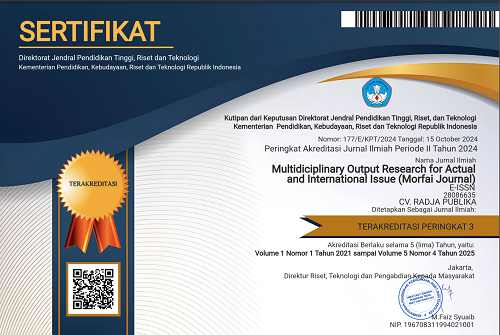DESIGNING E-CHARACTER ONLINE: AN EXAMINING ON INDONESIAN UNDERGRADUATE STUDENTS
Main Article Content
Nani Barorah Nasution
Nasrun
Erwita Ika Violina
Character education is one of the missions in Universities as a place for ordering prospective educators. In this research, we focused on develop designing an online web for developing character values: Discipline, Justice, Respect, Responsibility, Care and Citizenship. This is a Research and Development (R&D) study that aims to determine the development and feasibility of the Character Education Program with Web-based Application media at the Universitas Negeri Medan. Development models are 4-D models (Define), (Design), (Develop) and (Disseminate). The number of samples was 100 students of guidance and counseling undergraduate students that were randomly selected
Ferrari, A. (2006). The problem of civic cohesion and the role of the state school in France and Italy: Historical, religious and secular comparisons. Journal of Moral Education, 35(4), 533–550. https://doi.org/10.1080/03057240601027202
Gerbner, G., Gross, L., Morgan, M., & Signorielli, N. (1982). Charting the Mainstream: Television’s Contributions to Political Orientations. Journal of Communication, 32(2), 100–127. https://doi.org/10.1111/j.1460-2466.1982.tb00500.x
Lee, C. Y., Pan, P. J. Der, Liao, C. J., Chen, H. Y., & Walters, B. G. (2013). E-character education among digital natives: Focusing on character exemplars. Computers and Education, 67, 58–68. https://doi.org/10.1016/j.compedu.2013.02.020
O’Keeffe, G. S., Clarke-Pearson, K., Mulligan, D. A., Altmann, T. R., Brown, A., Christakis, D. A., Falik, H. L., Hill, D. L., Hogan, M. J., Levine, A. E., & Nelson, K. G. (2011). Clinical report - The impact of social media on children, adolescents, and families. Pediatrics, 127(4), 800–804. https://doi.org/10.1542/peds.2011-0054
Ruch, W., Martínez-Martí, M. L., Proyer, R. T., & Harzer, C. (2014). The Character Strengths Rating Form (CSRF): Development and initial assessment of a 24-item rating scale to assess character strengths. Personality and Individual Differences, 68, 53–58. https://doi.org/10.1016/j.paid.2014.03.042
Sugiyono. (2016). Quantitative, Qualitative and R&D Research Methods. Bandung: PT Alfabeta.
Tsfati, Y., Boomgaarden, H. G., Strömbäck, J., Vliegenthart, R., Damstra, A., & Lindgren, E. (2020). Causes and consequences of mainstream media dissemination of fake news: literature review and synthesis. Annals of the International Communication Association, 44(2), 157–173. https://doi.org/10.1080/23808985.2020.1759443
Villani, S. (2001). Impact of media on children and adolescents: A 10-year review of the research. Journal of the American Academy of Child and Adolescent Psychiatry, 40(4), 392–401. https://doi.org/10.1097/00004583-200104000-00007
Wright, T. A., & Emich, K. J. (2021). Character in crisis: The benefits of the 3-H approach to character development. Organizational Dynamics, 50(3), 100755. https://doi.org/10.1016/j.orgdyn.2020.100755
Ferrari, A. (2006). The problem of civic cohesion and the role of the state school in France and Italy: Historical, religious and secular comparisons. Journal of Moral Education, 35(4), 533–550. https://doi.org/10.1080/03057240601027202
Gerbner, G., Gross, L., Morgan, M., & Signorielli, N. (1982). Charting the Mainstream: Television’s Contributions to Political Orientations. Journal of Communication, 32(2), 100–127. https://doi.org/10.1111/j.1460-2466.1982.tb00500.x
Lee, C. Y., Pan, P. J. Der, Liao, C. J., Chen, H. Y., & Walters, B. G. (2013). E-character education among digital natives: Focusing on character exemplars. Computers and Education, 67, 58–68. https://doi.org/10.1016/j.compedu.2013.02.020
O’Keeffe, G. S., Clarke-Pearson, K., Mulligan, D. A., Altmann, T. R., Brown, A., Christakis, D. A., Falik, H. L., Hill, D. L., Hogan, M. J., Levine, A. E., & Nelson, K. G. (2011). Clinical report - The impact of social media on children, adolescents, and families. Pediatrics, 127(4), 800–804. https://doi.org/10.1542/peds.2011-0054
Ruch, W., Martínez-Martí, M. L., Proyer, R. T., & Harzer, C. (2014). The Character Strengths Rating Form (CSRF): Development and initial assessment of a 24-item rating scale to assess character strengths. Personality and Individual Differences, 68, 53–58. https://doi.org/10.1016/j.paid.2014.03.042
Rumapea, M. E. (2015). The Urgency of Character Education in Higher Education. JUPIIS, 7 (1), 49-59.
Tsfati, Y., Boomgaarden, H. G., Strömbäck, J., Vliegenthart, R., Damstra, A., & Lindgren, E. (2020). Causes and consequences of mainstream media dissemination of fake news: literature review and synthesis. Annals of the International Communication Association, 44(2), 157–173. https://doi.org/10.1080/23808985.2020.1759443
Villani, S. (2001). Impact of media on children and adolescents: A 10-year review of the research. Journal of the American Academy of Child and Adolescent Psychiatry, 40(4), 392–401. https://doi.org/10.1097/00004583-200104000-00007
Wright, T. A., & Emich, K. J. (2021). Character in crisis: The benefits of the 3-H approach to character development. Organizational Dynamics, 50(3), 100755. https://doi.org/10.1016/j.orgdyn.2020.100755
Nani Barorah Nasution, Universitas Negeri Medan, Medan
<strong>International Review of Practical Innovation, Technology And Green Energy (IRPITAGE)</strong> is a scientific journal that presents the results of scientific works sourced from Community Service in Indonesia. Contains All Forms of Novelty Innovations in both scientific science and technology, as well as issues of limited energy and the social environment in society.This journal is intended as a medium for scientific studies of research results from implementation to the community, thoughts and critical-analytic studies on various issues that can be utilized both nationally and internationally. The scientific article is in the form of a study of the implementation of Community Service that can be accounted for and disseminated nationally and internationally. IRPITAGE Journal from Radja Publika as part of the spirit of disseminating knowledge resulting from community service carried out by researchers in Indonesia. The IRPITAGE Journal from Radja Publika provides articles that can be downloaded for free. With a schedule of publications 3 (three) times a year.









